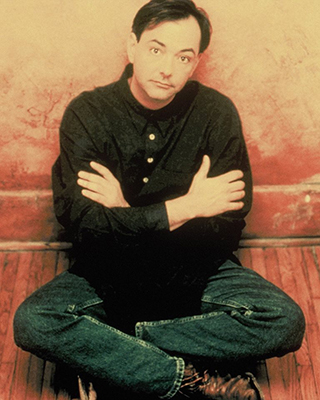Farewell Wichita
Rich Mullins Says Goodbye
by Stacey Beattie Stamps
Wichita Eagle May 12, 1995

Rich Mullins is heading to the Navajo Indian Reservation to begin a teaching career.
Contemporary Christian singer-songwriter Rich Mullins is leaving Wichita. That much is clear The rest is not so tidy.
Where are you going?
"I don’t really know," he said last week on the phone from his south Wichita home. Rumors have it that you're moving to Arizona to teach on an Indian reservation.
"It's the Navajo Nation reservation. It's the size of West Virginia."
Are the rumors true?
"If I knew I would tell you," he said with a laugh.
OK, OK. You are leaving?
"Yes" When you leave Wichita which direction will you be going?
"West" And where will you end up?
"West"
Sigh
"I don’t suppose I make plans the way other people do," he said "I set out to accomplish one task and when that's done my next plan is to kind of throw myself out there and see what opens up."
Mullins 39 said that he is heading for the Navajo Indian Reservation which stretches across parts of Arizona Utah and New Mexico but he has nothing concrete lined up. He will camp out a lot at first he said Before he leaves Mullins and his Ragamuffin Band will perform a "Farewell to Wichita" concert at 7:3O pm Saturday at Century H Concert Hall. The $12.50-a-ticket seats sold out a few hours after sales began.
Mullins a Wichltan since 1988 has been riding the wave of a successful music career since the early '80s. He's been nominated for 10 Dove Awards, most recently for "Hold Me Jesus," his No 1 single fa 1994. His songs have been performed by Amy Grant ,Debby Boone and Tony Melendez. His eighth album Brother's Keeper will be released in July and he's starting a 65-dty tour to the falL.
But with a music education degree from Friends University in hand, he is ready to follow another passion - teaching.
"Everything has a season and the important thing is to do what its time to do," Mullins said. "I think the only possible excuse for letting me muddle through a music career is to let me grow up a little bit so I can do something real."
His music has a purpose - to direct people to Christ, he said. And although he will continue writing songs and performing, he hopes teaching win allow him to reach more people on a smaller scale.
Mullins is a Christian "not because of a Christian concert that I went to or a book that I read," he said. "Its because somebody really stopped and said, 'Hey, here's something to talk about, do you want to listen?' or 'Wow, you look like you have something to talk about, can I listen to you?'"
The Navajo reservation has appealed to Mullins ever since be visited there years ago he said. He liked the lay of the land, the feel of the desert, the hot days and cool nights.
After being a full-time student at Friends University and a fulltime musician obliged to complete a recording contract, Mullins Is looking forward to Joining a culture where the pace is not so hectic.
"It just makes sense to go where a lot of people aren't lining up to go," he said.

The experience will also help him appreciate another culture and challenge his own biases.
"I don't think I'll ever be an Indian, I have no intention of being an Indian or a Native American or whatever the term is," Mullins said. "It's fun when your own set of biases are challenged."
Although some people may question his decision to trade an internationally successful music career for a small-time teaching job in a culture not his own, It makes perfect sense to Mullins.
"One of the hangups a lot of people have is that they think work is about making money," he said. "I think work is about being human. It doesn't matter to me that I would make less money at this job or that job. I don't have kids to feed. I don't have a wife to buy flowers for."
WHERE HE IS HEADING:
The Navajo Indian Reservation, which covers 16 million acres, is the nation's biggest reservation. It includes parts of Arizona, New Mexico and Utah. The Navajo call themselves Dine' (pronounced dihn EH), meaning "the people."
About 150,000 Mavajo live on the reservation. Some live in traditional tribal houses called hogans, which are made of earth and logs. Large numbers of the tribe are farmers or sheep ranchers, but others are engineers, miners, teachers and technicians.
During the 1600s, an increasing number of white settlers established ranches on the Navajo lands, and the Indians fought to drive the ranchers away. In 1864, U.S. Army troops led by Kit Carson destroyed the farms and homes of the Navajo. The soldiers forced about 8,000 Indians to march more than 300 miles to Fort Sumner, N.M. Thousands died along the way. The Navajo call this march the "Long Walk." In 1868, The Navajo agreed to settle on the reservation.
Source: World Book Encycolpedia.